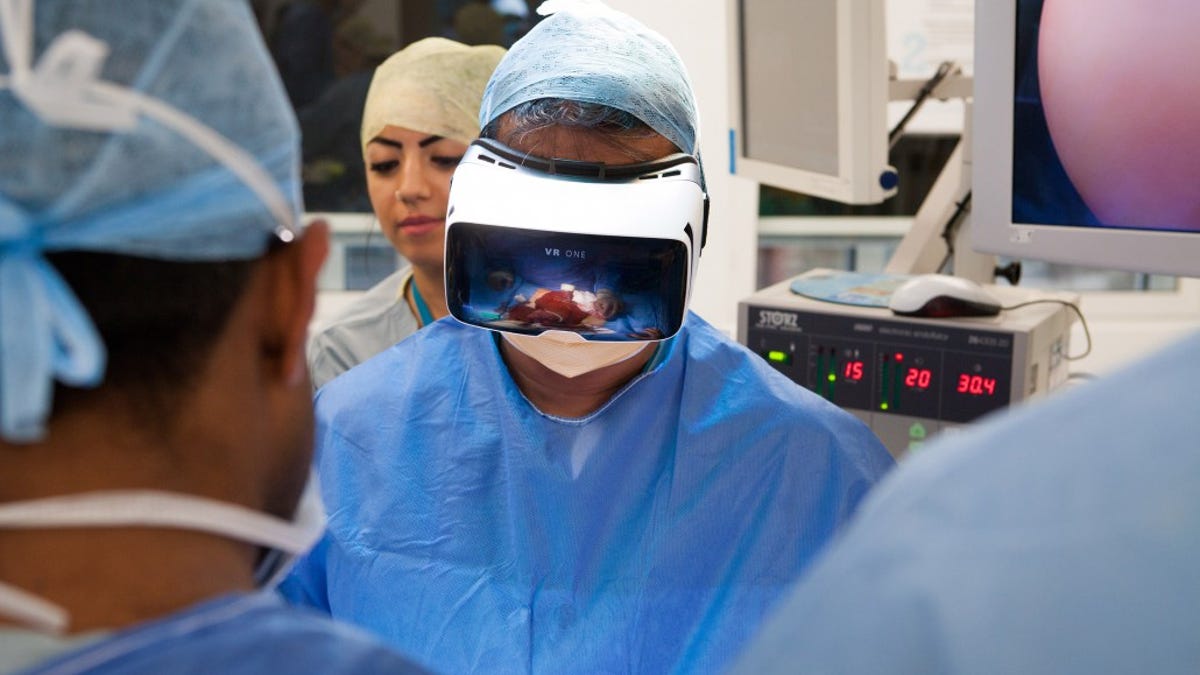Watch a cancer operation at any angle via Google Cardboard
A surgeon plans to live-stream one of his procedures in 360-degree video. You can follow along using even bargain-priced virtual-reality headsets.
Are you squeamish? You may want to look away now.
St. Bartholomew's Hospital in London next month will live-stream an operation on a cancer patient in 360-degree video so that it can be viewed by anyone in the world with a virtual-reality headset, including bargain-priced ones like Google Cardboard.
The live stream is set to be a world's first, according to colorectal and laparoscopic surgeon Dr. Shafi Ahmed, who will perform the two-hour operation. He didn't specify where the live stream would be broadcast, although sites like YouTube now show 360-degree video. Speaking at the Wearable Technology Show in London on Tuesday, Ahmed said he is keen to show curious people what happens when a cancer patient goes under the knife.
"You'll be with me in the operating theater," he said.
The live-streamed surgery represents the latest experiment with VR technology. While traditional virtual reality places you in a different digital world, it's often from a limited perspective. You can use headsets like Google Cardboard to view 360-degree photos and video, so that as you move your head in different directions to catch the action at different angles. Immersive VR is one of the hottest tech trends of the year, with heavy hitters like Samsung and Facebook looking to tap into areas including education and the military with the technology.
Ahmed, who is just one of several people in the medical field who are experimenting with virtual reality health care, said he is determined to educate surgeons in "places you would not imagine people being able to access surgical training." He said 5 billion people out of a global population of 7 billion are unable to access surgery.
This doesn't just apply to medically qualified trainee surgeons. Ahmed has used virtual reality to teach some basic surgical skills to former Apple Chief Executive John Sculley and even let a curious recovering patient replay their own operation.
Next up, he is going to prove just how accessible the technology by bringing a 360-degree camera rig decked out with GoPros into the operating theater so he can show the world how he works on a consenting cancer patient.
The exact date of the operation is yet to be confirmed, but is provisionally penciled in for the first two weeks of April. More information will come from St Bartholomew's.
From Google Glass to haptic feedback
It's easy to forget in 2016 that operating theaters get their names from the rows of seating where trainees would perch, straining to observe the action in order to learn how to do it themselves. But technology has changed all this.
"You don't have to fight to see the operation anymore," said Ahmed. Now trainees can watch an operation from a surgeon's point of view, even if they're thousands of miles away.
Ahmed has been instrumental in pioneering such teaching techniques. For two years, he tested using Google Glass, the camera-equipped, Internet-connected eyewear, to live-stream operations to his students, while fielding questions from them that appeared in his field of vision on Glass' head-up display.
Now he's moved onto virtual reality, which he believes has the potential to go beyond teaching technical skills needed to perform his job. "Surgery is so much more than that," he said, pointing out that learning in an immersive environment helps medical students cope with what's going on around them in the operating theater and experience what it's like when things go wrong.
The next step is to bring the sense of touch into the equation via tactile immersion and haptic feedback, something that's being experimented with in simulations using materials from balloons to exoskeletons for trainees to prod at and navigate around. "People are using all sorts of things to recreate the feel of the human body to the fingertips," said Ahmed.
The technology isn't quite there yet, he added, but it would be an ideal way to teach surgeons what to expect when they don't have access to the real thing.
"We've got to think about this because this is expensive medicine," said Ahmed. "Medical companies take you on the road -- actually do you need to? Why not give people headsets? Teach people remotely. They don't have to be barricaded."


